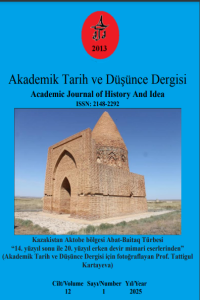Abstract
Eski Anadolu Türkçesi döneminde yazılmış Kur’an tercüme ve tefsirleri üzerine birçok akademik çalışma yapılmış ve yapılmaya devam etmektedir. Bu çalışmalarda ele alınan metinlerden biri de müellifi bilinmeyen bir Kur’an tefsirî olan Cevâhirü’l-Esdâf’tır. Tercüme, içerdiği Türkçe kökenli sözcük yoğunluğuyla, Arapçadan ve Farsçadan Türkçeye giren bazı sözcüklere gösterdiği tanıklıkla ve üretken Türkçesiyle incelenmeye değer bir nitelik göstermektedir. Bu çalışmada Cevâhirü’l-Esdâf’ın Hicrî 958 tarihli Dil ve Tarih-Coğrafya Fakültesi nüshası inceleme konusu edilmiştir. İki cilt biçiminde istinsah edilmiş bir nüshanın ikinci cildi olan eser; Meryem suresinden başlamakta ve Nâs suresinde bitmektedir. 274 varak metinden oluşan bu tefsirî tercüme, her bir sayfada 17 satır yer alacak şekilde düzenlenmiştir. Eserde Kur’an’a ait ifadeler kırmızı, Kur’an’ın sözlerini Türkçeleştiren bölümler ise siyah mürekkeple yazılmıştır. Eserin tamamı harekeli olup; yazı tipi olarak eserde nesih hat tercih edilmiştir. Bu makalede incelenen nüshanın muhtevası ve biçimsel nitelikleri hakkında bilgi verilmiş ve metnin yazıldığı dönemin dil özelliklerine dair örnekler irdelenmiştir. Bu çalışmanın amacı, kütüphane kayıtlarında ‘tefsir??????’ olarak meçhul bir tefsir biçiminde yer alan nüshanın kimliğini açıklığa kavuşturmak ve eser içinden örnekler sunmak suretiyle eserin sahip olduğu dönemsel dil özellikleri ile içerdiği dilsel zenginliği bilim dünyasına tanıtabilmektir.
References
- Abdülkadiroğlu, A. (1988). Cevahiru'l-Esdaf Esdaf’ın Müellifi veya Mütercimi Meselesi. Türk Tarihinde ve Kültüründe Kastamonu, Tebliğler (ss. 35-42). Gazi Üniversitesi Yayınları.
- Güloğlu, N.V. (2018). Bir Babadan Oğluna En Güzel Hediye: Cevahiru'l-Esdaf Tefsir., Osmanlı Döneminde Tefsir (s. 25-48). Ensar Neşriyat.
- Karakaya, M. (2010). Tarihî Kıpçak Metinlerinde Dinî Terminoloji [Yüksek lisans tezi, Gazi Üniversitesi]. Yök Tez.
- Küçük, M. (2014). Eski Anadolu Türkçesi Dönemine Ait Satır Arası İlk Kur’an Tercümesi. Türk Dil Kurumu Yayınları.
- Tokyürek, H. (2011). Eski Uygur Türkçesinde Budizm ve Manihaizm Terimleri [Doktora tezi, Erciyes Üniversitesi]. Yök Tez.
- Topaloğlu, A. (1982). Cevahirü’l-Asdâf Giriş-Metin-Sözlük [Doçentlik tezi, İstanbul Üniversitesi]. İstanbul Üniversitesi veritabanı.
- Topaloğlu, A. (1983). Kur’an-ı Kerim’in İlk Türkçe Tercümeleri ve Cevahirü’l-Asdâf. Türk Dünyası Araştırmaları, 27, 58-66.
- Uzunçarşılı, İ. H. (2003). Anadolu Beylikleri ve Akkoyunlu, Karakoyunlu Devletleri. Türk Tarih Kurumu Yayınları.
Abstract
Many academic studies on Qur'anic translations and commentaries written in the Old Anatolian Turkish period have been and continue to be conducted. One of the texts discussed in these studies is Cavāhir al-Asdāf, a Qur'an tafsir of unknown author. The translation is worth analysing with its high density of words of Turkish origin, its testimony to some words that entered Turkish from Arabic and Persian, and its productive Turkish. In this study, the Faculty of Language and History-Geography copy of Cavāhir al-Asdāf dated 958 AH has been analysed. The work, which is the second volume of a two-volume manuscript, begins with Surah Maryam and ends with Surah Nās. This 274-volume tafsir translation is organised in such a way that each page has 17 lines. In the work, the expressions belonging to the Qur'an are written in red ink, and the sections that translate the words of the Qur'an into Turkish are written in black ink. All of the work is in motion; naskh calligraphy is preferred as the font type in the work. In this article, information about the content and formal qualities of the analysed copy is given and examples of the linguistic characteristics of the period in which the text was written are examined. The aim of this study is to clarify the identity of the copy, which is included in the library records as ‘tafsir??????’ in the form of an unknown tafsir, and to introduce the linguistic richness of the work to the world of science by presenting examples from the work.
References
- Abdülkadiroğlu, A. (1988). Cevahiru'l-Esdaf Esdaf’ın Müellifi veya Mütercimi Meselesi. Türk Tarihinde ve Kültüründe Kastamonu, Tebliğler (ss. 35-42). Gazi Üniversitesi Yayınları.
- Güloğlu, N.V. (2018). Bir Babadan Oğluna En Güzel Hediye: Cevahiru'l-Esdaf Tefsir., Osmanlı Döneminde Tefsir (s. 25-48). Ensar Neşriyat.
- Karakaya, M. (2010). Tarihî Kıpçak Metinlerinde Dinî Terminoloji [Yüksek lisans tezi, Gazi Üniversitesi]. Yök Tez.
- Küçük, M. (2014). Eski Anadolu Türkçesi Dönemine Ait Satır Arası İlk Kur’an Tercümesi. Türk Dil Kurumu Yayınları.
- Tokyürek, H. (2011). Eski Uygur Türkçesinde Budizm ve Manihaizm Terimleri [Doktora tezi, Erciyes Üniversitesi]. Yök Tez.
- Topaloğlu, A. (1982). Cevahirü’l-Asdâf Giriş-Metin-Sözlük [Doçentlik tezi, İstanbul Üniversitesi]. İstanbul Üniversitesi veritabanı.
- Topaloğlu, A. (1983). Kur’an-ı Kerim’in İlk Türkçe Tercümeleri ve Cevahirü’l-Asdâf. Türk Dünyası Araştırmaları, 27, 58-66.
- Uzunçarşılı, İ. H. (2003). Anadolu Beylikleri ve Akkoyunlu, Karakoyunlu Devletleri. Türk Tarih Kurumu Yayınları.
Details
| Primary Language | Turkish |
|---|---|
| Subjects | Historical, Comparative and Typological Linguistics, Anatolia Language, Literature and Culture |
| Journal Section | Articles |
| Authors | |
| Early Pub Date | March 3, 2025 |
| Publication Date | April 8, 2025 |
| Submission Date | February 15, 2025 |
| Acceptance Date | March 3, 2025 |
| Published in Issue | Year 2025 Volume: 12 Issue: 1 |
По всем вопросам приема статей и выпуска очередных номеров обращаться в редакцию соответствующего журнала


